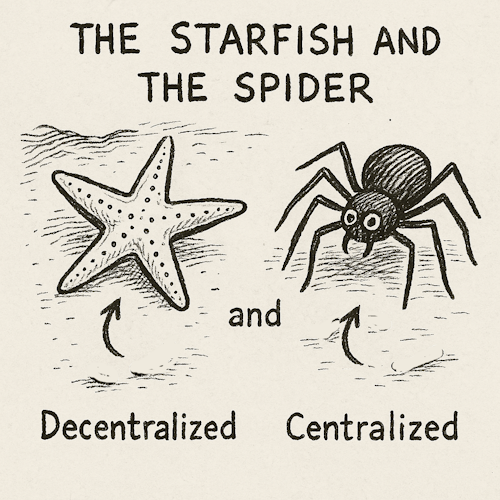The Starfish & The Spider
Illustrates Decentralization, Self-Management, Resilience
In Agile environments, teams are often told to be self-organizing, cross-functional, and empowered. But what does that really mean in practice? How do we structure organizations that can thrive without command and control leadership?
The metaphor from The Starfish and the Spider by Ori Brafman and Rod Beckstrom1 offers a compelling model for Agile thinking. In the book, starfish represent decentralized systems while spiders represent centralized ones. Understanding this metaphor helps Agile teams and leaders grasp how to build resilient systems that do not rely on a single point of failure.

Once upon a time, deep in the sea, lived a creature with no brain, no central nervous system, and no headquarters. The starfish. If you cut off a spider's leg, it becomes crippled. If you cut off its head, it dies. But if you cut off a starfish's leg, it grows a new one. In some species, the leg even grows a whole new starfish.
The starfish survives because it is decentralized. It has no single control point. Its power is distributed across its body. Each arm knows what to do.
Now imagine a pirate crew in the golden age of seafaring. You might expect a strict hierarchy. But many pirate ships operated more like starfish. They voted on captains, shared treasure, and made decisions together. If one leader fell, the crew still moved forward.
In contrast, a spider-like system breaks down when the leader is removed. The Roman Empire collapsed when its leadership crumbled. Blockbuster failed when its executives clung to outdated models. Centralized systems can be efficient, but they are fragile.
In today's fast-moving world, the most adaptable systems act more like starfish. The internet, open-source software communities, and some Agile teams thrive because they are decentralized, resilient, and able to evolve without waiting for orders.
Lessons Learned
Decentralization Enables Resilience
Agile teams perform better when decisions are made at the point of work. Centralized systems often create bottlenecks. When authority is distributed and knowledge is shared, teams can continue operating smoothly even if leaders are unavailable.
Self-Organizing Systems Grow Stronger With Disruption
Just as a starfish grows from a severed leg, resilient Agile organizations learn and regenerate through setbacks. Teams that embrace experimentation and learning loops do not fear failure. They adapt and grow.
Control Limits Innovation
Spiders require control to function. In complex, fast-changing environments, too much control slows innovation. Starfish-like systems thrive on autonomy, trust, and shared purpose. This mirrors the Agile principle of empowering individuals and trusting them to get the job done.
Change Is Not Linear
Spiders operate in hierarchies. Change flows from the top. But starfish systems spread influence peer to peer. Agile adoption often begins in small pockets, spreads organically, and gains strength through shared belief, not imposed policy.
The Structure Is the Strategy
The shape of the system shapes its behavior. Agile coaches must pay attention not just to process but to power dynamics, team design, and information flow. If you want adaptability, you have to design for it.
Coaching Tips
- Use this Story in Leadership Workshops to Compare Spider and Starfish Models: Ask, "What are we structured like now?" and "Where is that helping or hurting us?"
- With Teams, Map Who Decides What: Are decisions centralized or distributed? Use this as a starting point for delegation or redesign conversations.
- When Teams Recover from Setbacks or Step Up During Change: Point to this parable. Reinforce their capability as a decentralized, adaptive unit.
- Use this Metaphor: To launch conversations about systems thinking, complexity, and emergence.
Agility thrives where structure and culture support adaptability. The best teams do not wait for permission. They sense, decide, and act. They are not just faster spiders. They are starfish.
When teams begin to shape themselves, share leadership, act on their own insights, and recover from setbacks, you are not losing control. You are building a system that can survive the storm.
Let the spider be a warning. Let the starfish be your guide.


